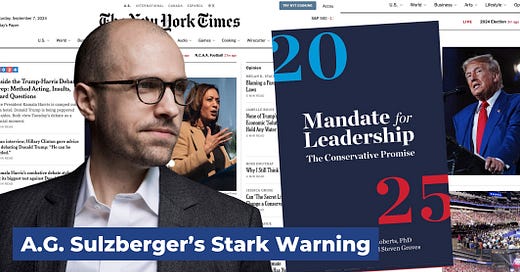A.G. Sulzberger’s Stark Warning: How Project 2025 Threaten Free Speech
In his fiery op-ed for The Washington Post, A.G. Sulzberger, publisher of The New York Times, delivers a stark warning about the future of free speech and independent journalism in the United States. Using the example of Hungary’s Viktor Orban, Sulzberger describes how authoritarian leaders can slowly dismantle press freedom through subtle bureaucratic tools like tax laws, broadcast licensing, and government subsidies. The result is a media landscape dominated by loyal outlets that parrot the government’s narratives while critical voices are silenced.
Sulzberger makes it clear this playbook is not a relic of faraway regimes but a potential threat in the U.S., especially with political figures like Donald Trump openly admiring these tactics. Trump’s labeling of the media as “the enemy of the people” was not just empty rhetoric; it signaled an increasingly dangerous attitude toward journalism. Allies like Kash Patel have made it explicit that Trump’s next term would see an even greater escalation in attacks on the free press, including the use of legal and bureaucratic measures to punish journalists and media outlets deemed hostile.
Sulzberger’s op-ed is a warning, but it is also a call to action as the U.S. approaches the possibility of a future where policies like those laid out in Project 2025 could take hold. This conservative policy agenda, crafted to guide a future Republican administration, poses a direct threat to the independence of journalism and the broader democratic framework that relies on it.
Public broadcasting would be one of the first targets under Project 2025. PBS and NPR, both seen as left-leaning by conservatives, play an essential role in providing fact-based, non-commercial news to the public.
The loss of public broadcasting would lead to an even greater concentration of media ownership in the hands of those who prioritize profit over public service, diminishing the diversity of viewpoints in the media landscape.
But the attack on journalism doesn’t end with defunding public broadcasters. Sulzberger highlights another critical threat: restricting press access to government officials. Trump’s first term saw multiple instances where journalists were denied access to press briefings or even banned from covering certain events. Project 2025 builds on this tactic by proposing that only journalists deemed favorable to the administration be allowed access to critical information. This selective access creates a system where only loyal outlets get the full story, while independent or critical journalists are sidelined.
Social media platforms are another key battleground in Project 2025. The project specifically targets Section 230 of the Communications Decency Act, a law that shields tech companies from liability for content posted by their users while allowing them to moderate harmful or misleading material. Conservatives argue that platforms like Facebook and Twitter have used Section 230 to unfairly censor conservative viewpoints, and Project 2025 seeks to strip away these protections if platforms are seen as engaging in politically biased moderation.
Sulzberger emphasizes the dangers of this approach. Without the ability to moderate harmful content, social media platforms could become breeding grounds for conspiracy theories, hate speech, and disinformation. This would further erode public trust in media, making it even harder to distinguish fact from fiction in the digital age.
Adding to the concern is Project 2025’s proposal to introduce “must-carry” laws, which would force platforms to host all legal political content, even if it violates their community guidelines. Sulzberger draws a direct comparison to Hungary, where similar laws ensure that government-approved narratives dominate while dissenting voices are drowned out. These laws don’t protect free speech; they create a chaotic environment where the most extreme voices are amplified at the expense of truth and accountability.
Sulzberger’s broader concern, which he lays out clearly in his op-ed, is that the erosion of press freedom doesn’t happen in an instant—it’s a slow, methodical process. It relies on sowing distrust in journalism, exploiting legal loopholes, and rewarding media outlets that serve the interests of those in power. Once independent journalism is sufficiently weakened, governments can act with impunity, shielded from public scrutiny.
Sulzberger’s fiery message is a call to arms for anyone who values democracy and the free flow of information. The threats posed by Project 2025 are not hypothetical; they are real, and they demand immediate attention. If we fail to defend the free press now, we risk losing one of the most important safeguards of our democracy.
The time to act is now. As Sulzberger warns, once the free press is undermined, it’s not just journalism that suffers -- it's democracy itself. If the American press is silenced, we risk becoming a nation where truth is dictated by those in power, and dissent is not tolerated. The cost of inaction is too high to ignore. We must protect the free press before it’s too late.




